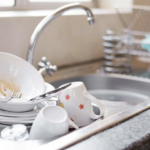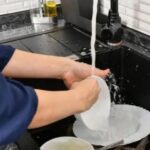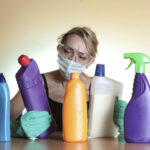Seeing a sink full of dishes, cups, pans, and cutlery that need to be cleaned can be daunting for anyone. Unfortunately, this household chore occurs daily and is hard to escape without a dishwasher. Hence, doing the dishes daily can feel like a chore for many. But with our tips below, doing the dishes will become a much lighter and quicker task.
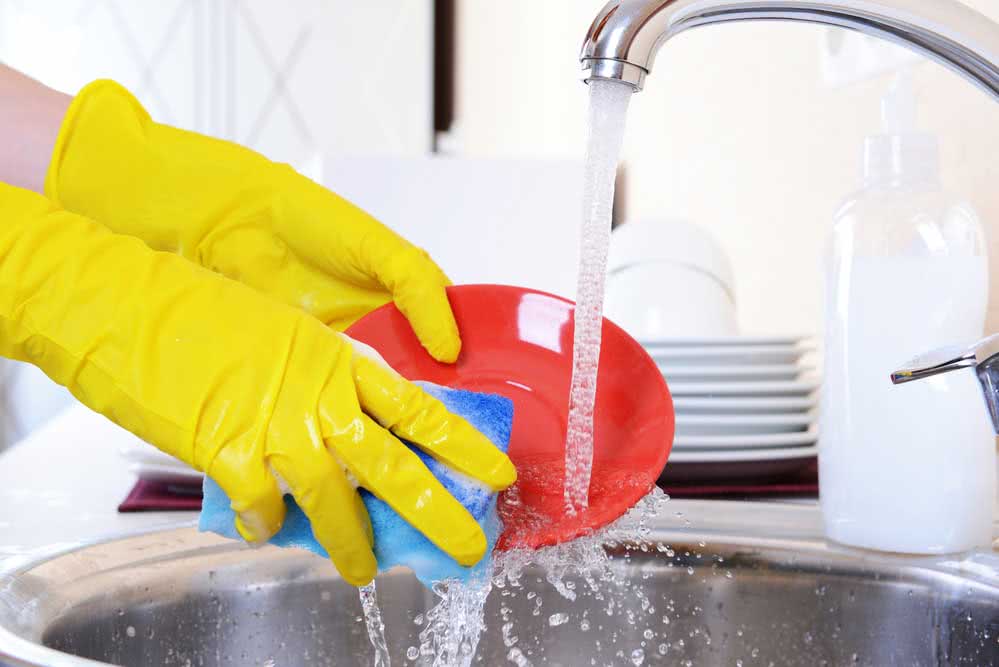
Tips for Quick and Easy Dishwashing
1. Keep the Kitchen Clean and Tidy
Maintaining a tidy kitchen is essential for the health and well-being of all household members. While it may take extra effort after each cooking session, regularly cleaning and organizing the kitchen will save a lot of time and energy in the long run.
A golden tip is to avoid letting dishes pile up in the sink. By washing what you use immediately after use, you’ll prevent leftover food and tough-to-clean grime from sticking to your utensils. It also helps a lot with quick meal preparation, as you’ll spend less time scrubbing pots and pans.

2. Wash Dishes While Cooking
Another crucial tip for quick dishwashing is to use the time you’re waiting for something to cook to wash the utensils you’ve just used for food preparation. Getting into the habit of washing dishes while cooking is a great way to prevent a pile-up in the sink.
Besides making good use of idle time while waiting for food to cook, washing dishes during cooking keeps the sink area clean and tidy, creating more space and reducing clutter in the kitchen. While this change may seem challenging and impractical, it’s worth trying! This way, after meals, you’ll have fewer dirty dishes to deal with, making the task much less time-consuming.
3. Dispose of Food Waste
A significant help in quickly washing dishes is to avoid letting dirty dishes with leftover food sit in the sink. Try to remove food residue with paper towels or scrape it off with cutlery before placing plates, pans, or bowls in the sink. This way, especially with the help of paper towels, you’ll eliminate most of the grime and grease, thus facilitating quicker dishwashing.
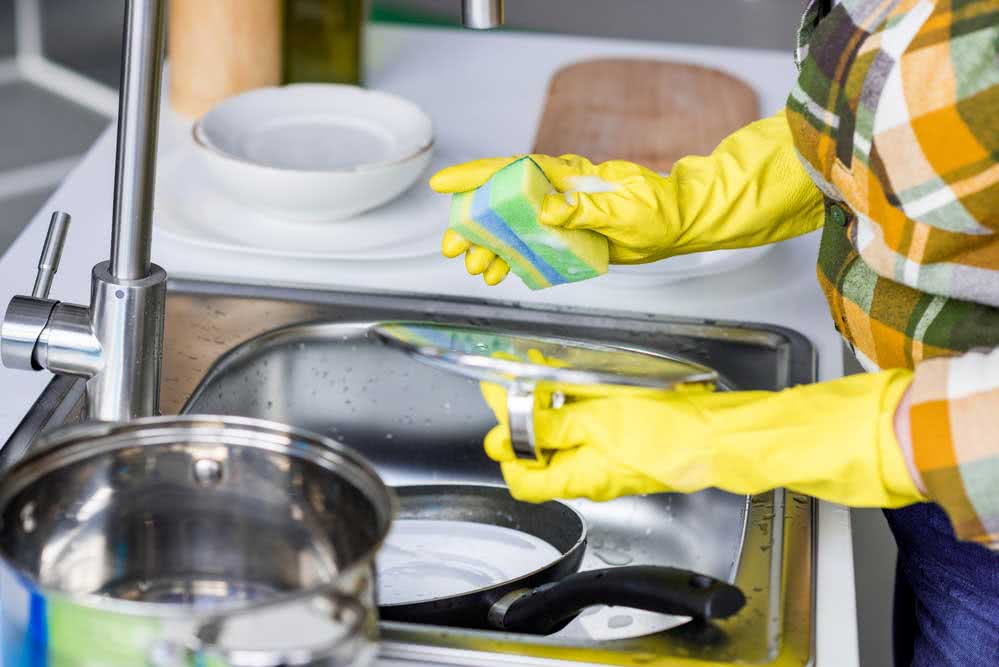
4. Soak the Dishes
If you don’t plan to wash the dishes immediately after placing them in the sink, always soak everything in water with a few drops of detergent. Of course, it’s ideal to wash dirty dishes right after use, but in the rush of daily life, this isn’t always possible.
So, one way to facilitate quicker dishwashing when you have time is always to soak dishes, cutlery, pans, and other utensils with detergent. This process, along with removing food residue with paper towels, will prevent grime from sticking to the dishes, thus facilitating and expediting the washing process later on.
5. Arrange the Dishes in the Sink
A seemingly small but helpful task for quick dishwashing is to arrange the dishes as you place them in the sink. Separate the oiliest and dirtiest utensils, such as pots, pans, and bowls, from those that don’t accumulate much dirt (like glasses).
Arrange similar dishes together inside the sink as follows:
– Stack plates with larger plates at the bottom and smaller ones on top;
– Place all cutlery inside a box with water and detergent;
– Never put glasses in the sink! Instead, keep them separate to avoid breakage and protect them from oil and grease.
– Keep pots, pans, and cauldrons separate from other utensils.
Arranging the sink not only makes the cleaning process easier and more time-saving but also prevents that overwhelming feeling when you look at a pile of dirty dishes.
How to Wash Dishes Faster?
Now that you have the initial organization tips, here are some tricks to speed up the dishwashing process significantly.
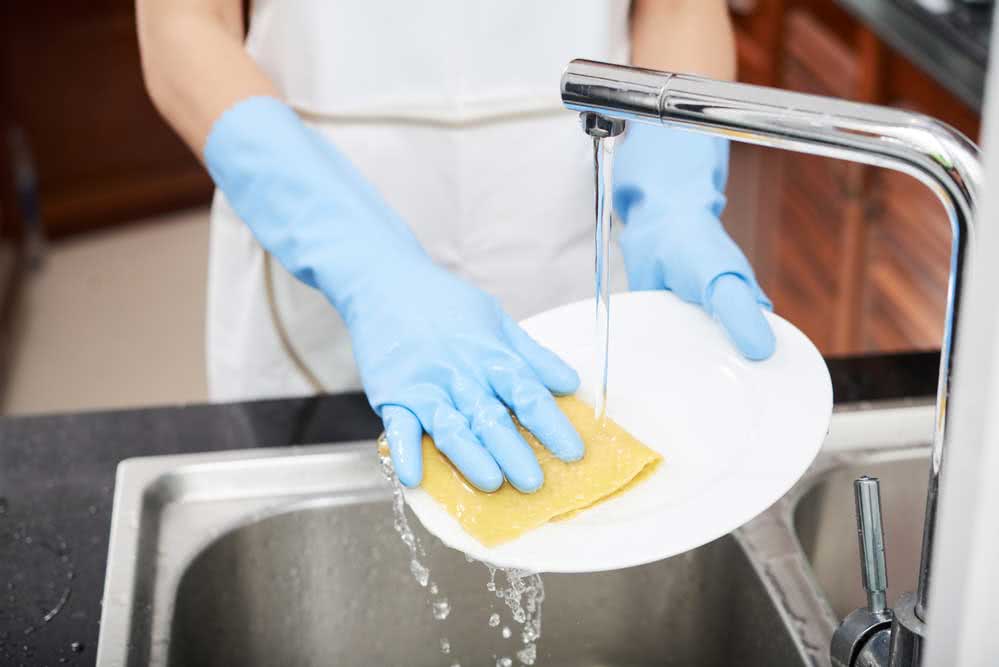
1. Wash in Order of Priority
Start washing dishes with the least dirty utensils. Since you’ve arranged the sink by separating items by type, it’s easy to identify which ones are the cleanest, so begin with those.
By washing the least dirty items first, you’ll prevent grease from the others from sticking to your sponge and dirtying the first ones. A good sequence for quick dishwashing is to start with glasses, move to cutlery, then plates, pots, and finally, pans.
2. Use Hot Water for Greasy Items
A trick to make cleaning greasy items easier is to use hot water to help remove dirt. Boil some water and pour it over the toughest-to-clean items. You’ll see that grease will come off much more easily.
3. Use Baking Soda to Remove Stubborn Stains
For pans with stubborn stains that refuse to budge even after hours of soaking, regular detergent may not be enough. Here’s where baking soda comes in—it’s a powerful agent for removing stains and grime.
Add a little baking soda to the pan and mix it with hot water. Let the solution sit for a few minutes, then use a sponge or dish brush to clean it. You’ll find that the caked-on grime will come off much more easily.
By An Nhien – Vietnamnet
– Fill your sink with hot, soapy water before you start washing. This will help to loosen any stubborn grease or food residue.
– Use a good quality, scratch-resistant sponge or brush to avoid leaving marks on your dishes.
– Start with the least greasy items first, such as glasses and cups, and work your way to the greasiest items like pots and pans.
– For heavily soiled items, use a combination of baking soda and vinegar to create a fizzing action that helps lift away dirt and grease.
– Rinse dishes with warm water and ensure they are free of soap residue, as this can leave water marks.
– Dry dishes with a clean, lint-free cloth for a streak-free shine.
The 5 Places to Keep Empty in Your Home: It’s Not Superstition, There’s a Reason
The kitchen is a pivotal space that should be kept clear and clutter-free. It is the heart of the home, where culinary creations come to life and memories are made. A tidy kitchen not only makes cooking and cleaning more efficient but also creates a calming and inviting atmosphere for both the chef and their guests.

























